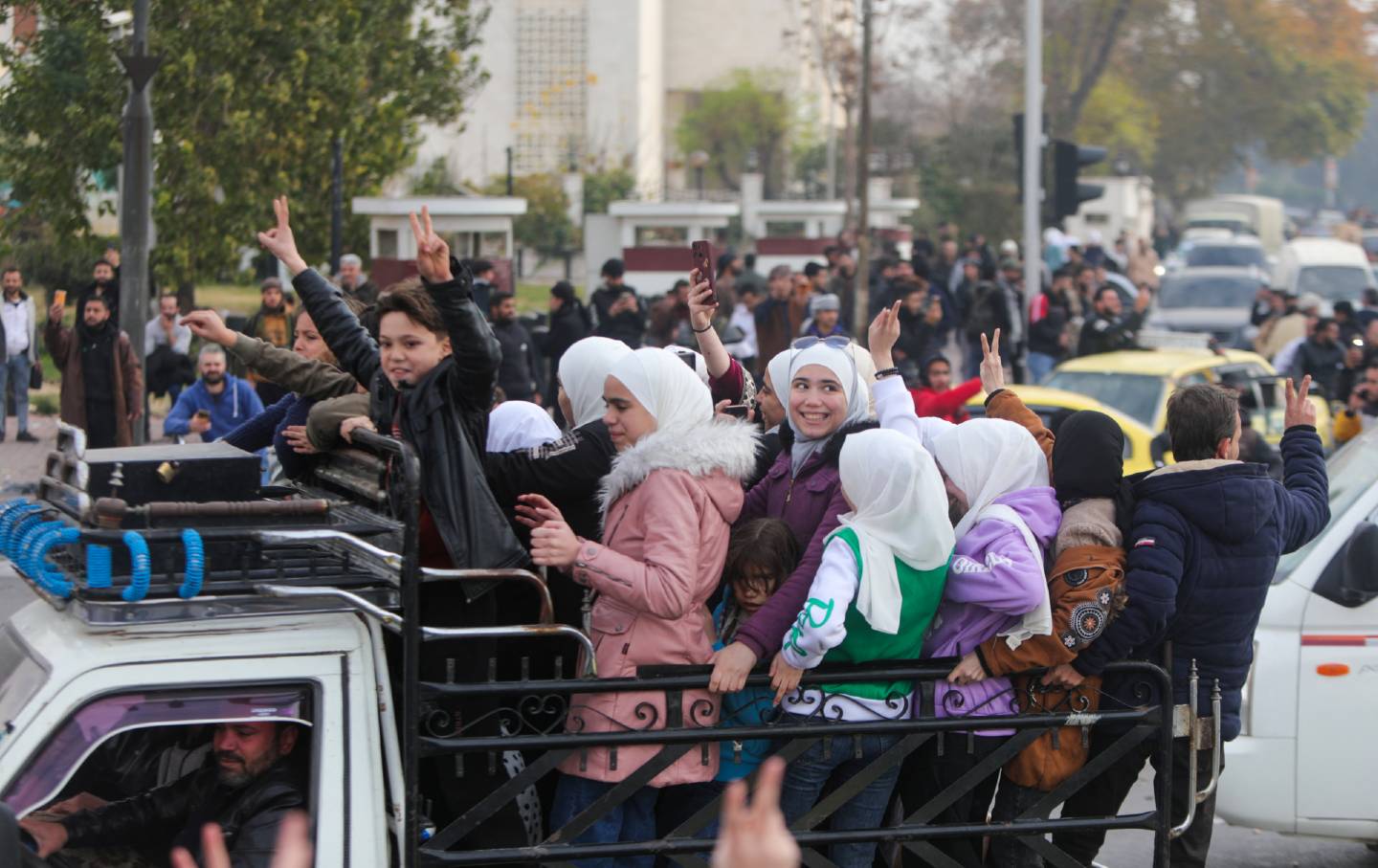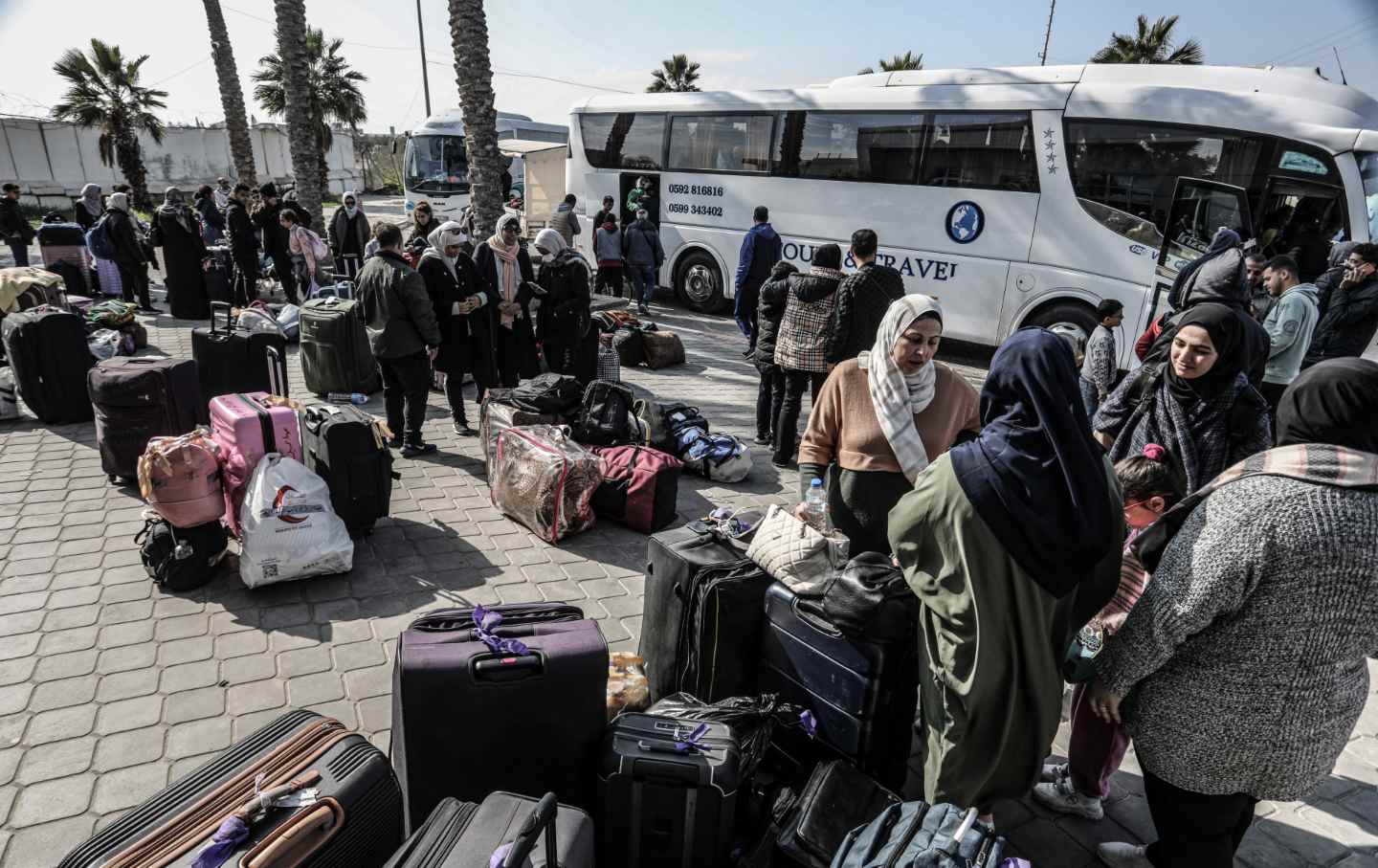The War on Gaza Comes With a Label: “Made in the USA”
Any national leader with a strong sense of justice, of right and wrong, would do whatever was necessary to stop a genocide like the one now unfolding in Gaza.

President Joe Biden joined Israel’s prime minister for the start of the Israeli war cabinet meeting, in Tel Aviv on October 18, 2023.
(Miriam Alster / AFP via Getty Images)This article originally appeared at TomDispatch.com. To stay on top of important articles like these, sign up to receive the latest updates from TomDispatch.com.
It’s been almost two months since the International Court of Justice ordered Israel to stop killing Gazans and destroying their means of subsistence. So let’s look back and ask (1) how Israel has responded to its “orders,” and (2) how hard the Biden administration has pushed Israel to abide by those orders. Spoiler alert: The short answers are (1) not well and (2) not very.
The American government has provided most of the armaments and targeting technologies being used to kill Gazans by the thousands while turning many of the rest of them into refugees by destroying their homes, offices, schools, and hospitals. Nor did the Biden administration threaten to withdraw that support when Israel blocked shipments of crucial food and fuel to the 25-mile-long Gaza Strip. It also keeps vetoing UN Security Council resolutions that would hold Israel accountable. And President Biden, despite an increasing amount of rhetorical shuffling, continues to back Prime Minister Benjamin Netanyahu and the Israeli Defense Forces (IDF), even though they have ignored the International Court’s orders and continue committing atrocities.
Flouting the Order to Stop the Killing
On January 26, the International Court of Justice handed down a ruling in a case brought by the Republic of South Africa accusing Israel of genocide. It ordered that Israel must “ensure with immediate effect that its military does not commit any acts described” in the United Nations Convention on the Prevention and Punishment of the Crime of Genocide.
The court’s first order prohibited “killing members” of the Palestinian population or “causing serious bodily or mental harm” to them. How did Israel respond? Consider that, between late December 2023 and January 21st of this year, the IDF had killed about 5,000 Palestinians, already pushing the death toll in the Gaza Strip past 25,000. The court’s order, issued days later, would have essentially zero effect. Another 5,000-plus Palestinians would be killed by late February, raising the death toll to more than 30,000.
During the month after the ruling, Israeli troops repeatedly killed or injured civilians fleeing to, or taking shelter in, areas the IDF had advertised as “safe zones.” Typically, when, on February 12th, Israeli aircraft attacked 14 homes and three mosques in the southern Gaza city of Rafah, killing 67 Palestinians, some of the survivors told reporters that they’d been inside tents in a refugee camp. Similarly, on February 22, Israeli warplanes struck a residential area in central Gaza, killing 40 civilians, mostly women and children, and wounding more than 100.
Worse yet, the Biden administration has enabled that ongoing killing spree by approving 100 separate military sales to Israel since the conflict began in October. As a former administration official told The Washington Post, “That’s an extraordinary number of sales over the course of a pretty short amount of time, which really strongly suggests that the Israeli campaign would not be sustainable without this level of U.S. support.”
In other words, the backbone of the war on Gaza comes with a label: “Made in USA.” In the decade leading up to October 7, as the Stockholm International Peace Research Institute has reported, two-thirds of Israel’s arms imports came from the United States. (From 1950 to 2020, the UN share was a whopping 83 percent!)
In just the first couple of months of the war, the Biden administration sent 230 cargo planes and 20 ships full of military goods to Israel, a trove that included 100 BLU-109 bombs (2,000-pounders designed to penetrate hardened structures before exploding), 5,400 MK84 and 5,000 MK82 bunker-busters, 1,000 GBU-39 bombs, 3,000 JDAM bomb-guidance kits, and 200 “kamikaze drones.”
Such powerful bombs, reported Al Jazeera, “have been used in some of the deadliest Israeli attacks on the Gaza Strip, including a strike that leveled an apartment block in the Jabalia refugee camp, killing more than 100 people.” And yes, such bunker-busters were widely used in the UN wars in Iraq and Afghanistan, but not in places as densely populated as Gaza’s cities. Israeli sources tried to justify that particular death toll by insisting it was necessary to kill one of Hamas’s leaders. If so, we’re talking about a 100-to-1 ratio, or a kind of collective punishment being supported by our tax dollars.
Worse yet, our military seems to have been participating directly in the IDF’s operations. According to The Intercept’s Ken Klippenstein and Matthew Petti, the Defense Department has been providing satellite intelligence and software to help the IDF find and hit targets in Gaza. An “Air Defense Liaison Team,” they report, even traveled to Israel in November to offer targeting help, adding that “for the first time in UN history, the Biden administration has been flying surveillance drone missions over Gaza.”
And even then, some members of Netanyahu’s government felt it wasn’t enough. Far right-wing Finance Minister Bezalel Smotrich put it this way when it came to President Biden’s warning not to send the IDF into the southern Gazan city of Rafah where hundreds of thousands of refugees were gathered: “American pressure or fear of harming civilians should not deter us from occupying Rafah and destroying Hamas.”
The Israeli hostages held by Hamas are the excuse for so much of this, but the way to free them would be to negotiate, as Israel did successfully last fall, not try to “wipe Hamas off the face of the earth.” The Israelis are mostly bombing civilian sites in that campaign, because they’re reluctant to fight their way through the vast fortified network of tunnels from which the military wing of Hamas, the Qassam Brigades, mounted a formidable resistance to the invasion, largely with weaponry they manufactured themselves, along with ammunition recycled from unexploded ordnance dropped in past Israeli attacks.
Conditions of Life (and Death)
In the second of its orders, the International Court of Justice prohibited “deliberately inflicting… conditions of life calculated to bring about its physical destruction in whole or in part [or] imposing measures intended to prevent births within the group.”
The Netanyahu government and the IDF blew off this directive as well. In the month that followed the ruling, Israeli troops continued to besiege hospitals across Gaza, thoroughly crippling, if not destroying, its healthcare system, especially two of its most important facilities: Al-Shifa Hospital in the north and Nasser Hospital in the south. Before it was put out of service in mid-February, Nasser was one of the last hospitals still operating there in any capacity whatsoever. Not surprisingly, the World Health Organization has since reported a striking rise in respiratory infections, diarrhea, chickenpox, jaundice, skin rashes, and scabies, among other horrors.
Israel’s military has also been making conditions unlivable by restricting the food aid entering the territory and destroying local fishing boats, greenhouses, and orchards. It’s a formula for mass starvation. As Michael Fakhri, the UN special rapporteur on the right to food, told The Guardian in late February, “The speed of malnourishment of young children is also astounding. The bombing and people being killed directly is brutal, but this starvation—and the wasting and stunting of children—is torturous and vile.” Around the same time, UNICEF announced that 90 percent of children under 5 in Gaza were consuming “two or fewer food groups a day,” the functional definition of “severe food poverty.” About the same percentage were suffering from infectious diseases, most commonly diarrhea, which only exacerbated their malnutrition.
The world’s top group tracking food emergencies reported on March 17 that famine “is now projected and imminent” in northern Gaza within six weeks, and that “half of the population of the Gaza Strip (1.11 million people) is expected to face catastrophic conditions,” with starvation and death expected to be widespread. Keep in mind that, under the Geneva Conventions, it’s a war crime to starve civilians or “attack, destroy, remove, or render useless any items necessary for civilians’ survival.” Attacking a hospital can also be a war crime. In that context, here’s a thought experiment: What would President Biden and his top officials do if they suspected any other country of committing acts it knew could potentially lead to mass civilian deaths from starvation and disease? Would they shower it with more weaponry?
In defiance of the International Court’s orders—and undeterred by mild tut-tutting from Washington—the Israeli military is also inflicting intolerable “conditions of life” with its approach to Gaza’s water supply. With fuel shipments blocked by the Israelis, Gazans are unable to keep running the desalinization plants that produce a significant amount of the Strip’s water. As a result, by late February, the water supply had dropped to 7 percent of its prewar level. In desperation, many Gazans, especially children, have been forced to turn to polluted water sources, putting them at risk of severe gastrointestinal disease with no functional hospitals to help them.
Popular
“swipe left below to view more authors”Swipe →Israel is also, in effect, violating the International Court’s bar on “measures intended to prevent births,” since pregnant women are considered especially vulnerable to the food deprivation that is now the essence of life in Gaza. At the Deir al Balah clinic in central Gaza, one out of five maternity patients were being treated for malnutrition in February, causing doctors deep concern, since any malnourished mother will be carrying a malnourished fetus (with awful health prospects for both of them). Meanwhile, the UN Population Fund reports that women are miscarrying at a higher rate than before the war, while doctors are being forced to perform emergency caesarian sections without anesthetics, posing a high risk to both mother and child.
Smoke and Parachutes
The International Court of Justice’s third order was to “enable the provision of urgently needed basic services and humanitarian assistance to address the adverse conditions of life faced by Palestinians in the Gaza Strip.” Israel’s leaders are ignoring that as well—or maybe they’ve just reinterpreted “enable” to mean “thwart.”
In January, before the court order, the IDF had been allowing approximately 140 aid trucks through their checkpoints into Gaza daily, instead of the 500 of the prewar period. If Gazans’ needs were to be fully satisfied, that flow of aid should have been steeply increased. Instead, the Israelis reduced the number of trucks allowed into Gaza to only 96 per day in February, all too literally feeding fears of starvation.
To make matters worse, groups of Israeli civilians have been blocking aid convoys, some by lying on the ground in front of the trucks. On a single day in February, 130 trucks were blocked and the IDF made no effort to deter the demonstrators. The Association of International Development Agencies reported that, even when their trucks were getting through the southern border crossings, most of them weren’t managing to reach the central or northern parts of the Strip, including Gaza City, because they were “hindered by Israeli military operations, including constant bombardment and checkpoint closures.”
The most notorious aid-denial incident occurred on February 27, when at least 118 Palestinians were killed after Israel forces opened fire on a crush of people in Gaza City trying to get food from a truck convoy. Most of the victims of this “Flour Bag Massacre” seem to have been killed either by IDF troops firing from tanks or to have died in the crush of people desperately trying to escape being shot.
The Biden administration did not respond to such incidents as it should have—by threatening to cut off war funding and supplies to Israel, as it had earlier suspended financial support for the United Nations Relief and Works Agency (UNRWA), Gaza’s biggest prewar supplier of food, water, and shelter. The reason: allegations that some Palestinian UNRWA staff had, in the past, aided Hamas. Now, however, Reuters and The Times of Israel suggest that several agency staff members released from Israeli detention were coerced into falsely “admitting” to Hamas affiliations through physical beatings, waterboarding, and threats to their family members. (US aid is still being withheld from UNWRA.)
Instead of pushing the Netanyahu government ever harder to allow more aid, the Biden administration decided to put on an airshow by dropping pallet-loads of packaged food into Gaza from military aircraft. Aid organizations panned the airdrops as little more than empty “gestures,” or a “theater of cruelty.” Even a hulking C-130 cargo plane can carry only the equivalent of one or two aid trucks. And despite similar expenditures, such airdrops can deliver only one-eighth to one-tenth as much food as a truck convoy. Worse yet, tons of cargo dropped from the sky can itself prove deadly. During an airdrop over a refugee camp along the northern Gaza coast on March 8, a parachute failed to open, and the heavily loaded pallet attached to it plummeted into a group of adults and children who had been watching the drop from a rooftop. Five of them were killed, and 10 injured.
To Netanyahu & Co., the orders issued by the International Court of Justice have had about as much impact as a mosquito bite. And the United States, which could put more pressure on Israel than any other nation, has shied away from substantive action of any sort. President Biden and other officials continue to act largely as if they were just bystanders and the carnage in Gaza was being caused by some random natural disaster.
We aren’t policy experts, but it seems to us that any national leader with a strong sense of justice, of right and wrong, would do whatever was necessary to stop a genocide like the one now unfolding in Gaza. He or she would at least threaten to end all military support to Israel and press other supplying nations to do the same. He or she would put real effort into forcing Israel to let the aid trucks roll in and allowing Palestinians to decide their own fate.
Sadly, those aren’t our leaders. For now, Palestinians remain trapped in a nightmare vividly evoked by a recent photo that shows pallets of food aid parachuting earthward into Gaza as plumes of smoke from Israeli air strikes rise to meet them—with both the food and the munitions courtesy of the United States of America.
More from The Nation

Celebrations in Syria May Be Premature Celebrations in Syria May Be Premature
The speed of the Assad dictatorship's collapse stunned even the opposition. But the result is a power vacuum that Israel and Turkey have already moved to occupy.

The Fall of Syria Changes Everything The Fall of Syria Changes Everything
Retired diplomat Chas Freeman and writer Pascal Lottaz discuss what happens now that Damascus is in the hands of Hayat Tahrir al-Sham.

Netanyahu Must Be Brought to Justice. But We Can’t Stop There. Netanyahu Must Be Brought to Justice. But We Can’t Stop There.
This genocide is a massive criminal undertaking, and we must hold as many of its perpetrators accountable as we can.

My Brother, Chef Mahmoud Almadhoun, Died Because He Fed Gaza’s Starving Citizens My Brother, Chef Mahmoud Almadhoun, Died Because He Fed Gaza’s Starving Citizens
His killing by Israel sent a chilling message that no one is safe, including humanitarians who stand in the way of Gaza’s erasure.

The Underground Network Helping Gazan Refugees Survive in Egypt The Underground Network Helping Gazan Refugees Survive in Egypt
A patchwork of volunteer-run mutual aid organizations has sprung up to tackle the severe problems facing people fleeing genocide.

The Dangers of Trump’s Foreign Policy The Dangers of Trump’s Foreign Policy
Strategic incoherence and factionalism reign.


